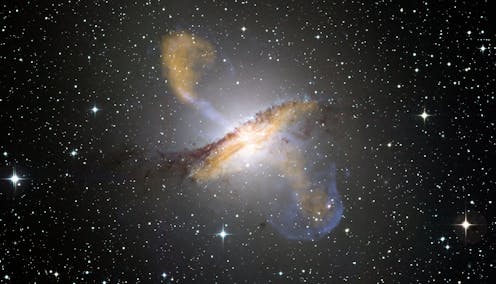Egg-shaped galaxies may be aligned to the black holes at their hearts, astronomers find
- Written by David Parkinson, Research Scientist in Astrophysics, The University of Queensland

Black holes don’t have many identifying features. They come in one colour (black) and one shape (spherical).
The main difference between black holes is mass: some weigh about as much as a star like our Sun, while others weigh around a million times more. Stellar-mass black holes can be found anywhere in a galaxy, but the really big ones (known as supermassive black holes) are found in the cores of galaxies.
These supermassive behemoths are still quite tiny when seen in cosmic perspective, typically containing only around 1% of their host galaxy’s mass and extending only to a millionth of its width.
However, as we have just discovered, there is a surprising link between what goes on near the black hole and the shape of the entire galaxy that surrounds it. Our results are published in Nature Astronomy.
When black holes light up
Supermassive black holes are fairly rare. Our Milky Way galaxy has one at its centre (named Sagittarius A*), and many other galaxies also seem to host a single supermassive black hole at their core.
Under the right circumstances, dust and gas falling into these galactic cores can form a disk of hot material around the black hole. This “accretion disk” in turn generates a super-heated jet of charged particles that are ejected from the black hole at mind-boggling velocities, close to the speed of light.
When a supermassive black hole lights up like this, we call it a quasar.
How to watch a quasar
To get a good look at quasar jets, astronomers often use radio telescopes. In fact, we sometimes combine observations from multiple radio telescopes located in different parts of the world.
Using a technique called very long baseline interferometry, we can in effect make a single telescope the size of the entire Earth. This massive eye is much better at resolving fine detail than any individual telescope.
As a result, we can not only see objects and structures much smaller than we can with the naked eye, we can do better than the James Webb Space Telescope.
This is the technique that was used to make the first “black hole image” in 2019, showing the halo of light generated around the supermassive black hole hosted by the galaxy M87.
Quasar jets that can be detected using very long baseline interferometry can be millions of light years long and are almost always found in elliptical galaxies. Using very long baseline interferometry, we can observe them all the way down to a few light years or so from their black hole of origin.
The direction of the jet near its source tells us about the orientation of the accretion disk, and so potentially the properties of the black hole itself.
Connection to the host galaxy
What about the host galaxies? A galaxy is a three-dimensional object, formed of hundreds of billions of stars.
But it appears to us (observed in optical or infrared) in projection, either as an ellipse or a spiral. We can measure the shape of these galaxies, tracing the profile of starlight, and measure the long axis and short axis of the two-dimensional shape.
In our paper, we compared the direction of quasar jets with the direction of this shorter axis of the galaxy ellipse, and found that they tend to be pointing in the same direction. This alignment is more statistically significant than you would expect if they were both randomly oriented.
This is surprising, as the black hole is so small (the jets we measure are only a few light years in length) compared to the host galaxy (which can be hundreds of thousands or even millions of light years across).
It is surprising that such a relatively small object can affect, or be affected by, the environment on such large scales. We might expect to see a correlation between the jet and the local environment, but not with the whole galaxy.
How galaxies form
Does this have something to say about the way galaxies form?
Spiral galaxies are perhaps the most famous kind of galaxy, but sometimes they collide with other spirals and form elliptical galaxies. We see these three-dimensional egg-shaped blobs as two-dimensional ellipses on the sky.
The merger process triggers quasar activity in ways we don’t fully understand. As a result, almost all quasar jets that can be detected using very long baseline interferometry are hosted in elliptical galaxies.
The exact interpretation of our results remains mysterious, but is important in the context of the recent James Webb Space Telescope discovery of highly massive quasars (with massive black holes), which have formed much earlier in the universe than expected. Clearly, our understanding of how galaxies form and how black holes influence that needs to be updated.
Authors: David Parkinson, Research Scientist in Astrophysics, The University of Queensland





